Laid down 23 August 2007 Launched 8 March 2008 Draft 14 m | Yard number 2234 Construction started 23 August 2007 Length 316 m Beam 46 m | |
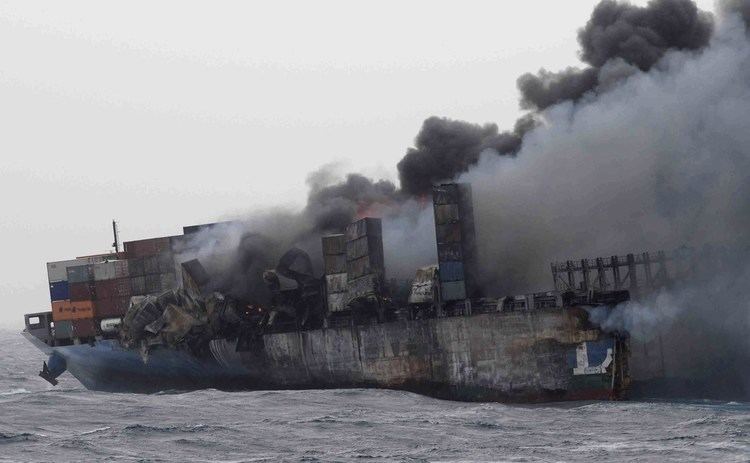 | ||
Name MOL Comfort (2012–2013)APL Russia (2008–2012) Owner Ural Container Carriers SA (2011–2013)MOL Euro-Orient Shipping SA (2008–2011) Builders | ||
Mol comfort drifting off yemeni coast taped by seamen of nearby ship
MOL Comfort was a 2008-built Bahamian-flagged post-Panamax container ship chartered by Mitsui O.S.K. Lines. On 17 June 2013, she broke into two about 200 nautical miles (370 km; 230 mi) off the coast of Yemen. The aft section sank on 27 June and the bow section, after having been destroyed by fire, on 11 July.
Contents
- Mol comfort drifting off yemeni coast taped by seamen of nearby ship
- Rescuing mol comfort
- Career
- Shipwreck
- General characteristics
- References

Rescuing mol comfort
Career
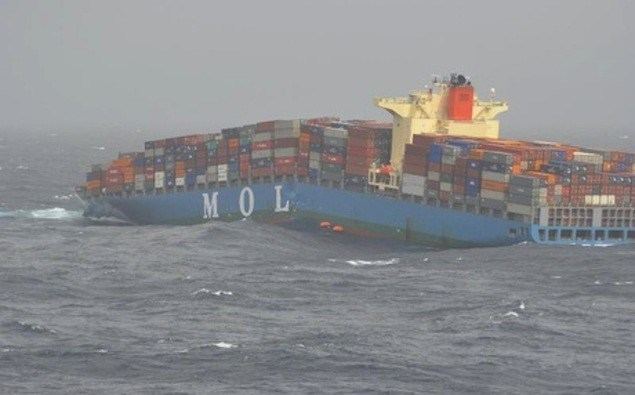
One of twelve ships of similar design, MOL Comfort was laid down at Mitsubishi Heavy Industries Nagasaki shipyard in Japan on 23 August 2007 and launched on 8 March 2008 as APL Russia for charter to APL (formerly American President Lines). She was completed on 14 July 2008. On 1 June 2012, APL Russia was transferred to Mitsui O.S.K. Lines' Europe-Asia route and renamed MOL Comfort.
Shipwreck
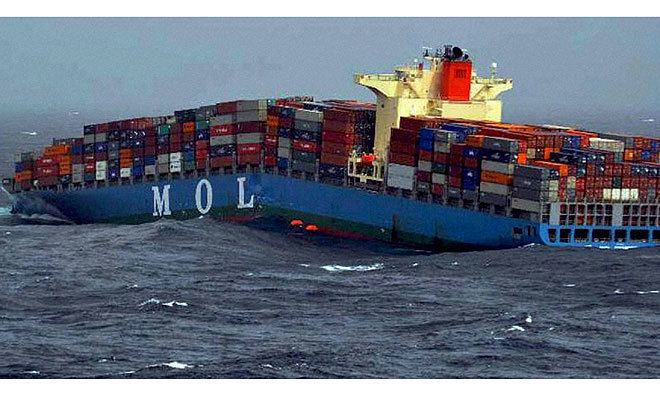
On 17 June 2013, MOL Comfort suffered a crack amidships in bad weather about 200 nautical miles (370 km; 230 mi) off the coast of Yemen and eventually broke into two. The vessel was underway from Singapore to Jeddah, Saudi Arabia, with a cargo of 4,382 containers equivalent to 7,041 TEU. The crew of 26—11 Russians, one Ukrainian and 14 Filipinos—abandoned the ship and were rescued from two life rafts and a lifeboat by the German-flagged container ship Yantian Express, one of three vessels diverted to the site of incident by ICG Mumbai. After the structural failure, both sections remained afloat with the majority of the cargo intact and began drifting in an east-northeast direction. Smit Salvage Singapore was contracted to tow the sections to safety.
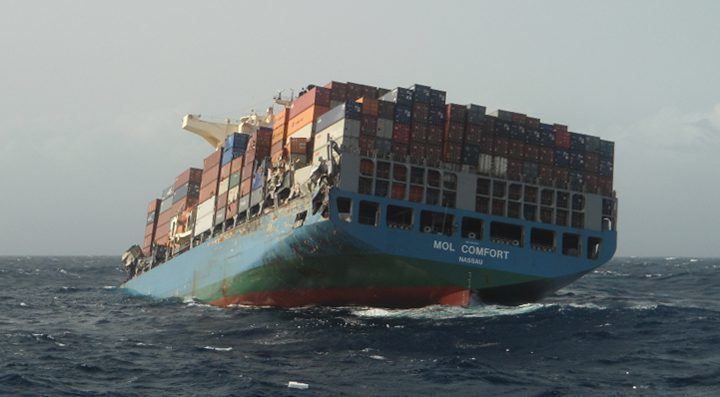
On 24 June, four oceangoing tugboats arrived at the scene and began towing the bow section to safety. However, before any salvage operations of the stern section could commence, water ingress was reported on 26 June. On the following day, the stern sank at 14°26′N 66°26′E to a depth of 4,000 metres (13,000 ft). Some of the approximately 1,700 containers on board were later confirmed floating near the site. While no major oil leak was reported, the stern section was said to contain about 1,500 tons of fuel.

On 2 July, the tow of the bow section broke free in bad weather but the towing line was reattached the next day. On 6 July a fire broke out in the rear part of the bow section. Unable to get the blaze under control in bad weather the salvage vessels asked for help from an Indian Coast Guard patrol boat with external fire fighting equipment. By 10 July most of the 2,400 containers on board had been destroyed by fire. The damaged bow section sank the next night at 19°56′N 65°25′E to a depth of 3,000 metres (9,800 ft) with what remained of the cargo and 1,600 metric tons of fuel oil in the tanks. No spill apart from a thin oil film on the surface has been reported, but some containers were spotted floating around the sinking site. The cause of the fire remains unknown.
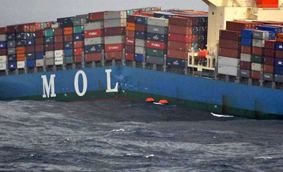
The exact cause of the accident is not known. On 4 July, Mitsui O.S.K. Lines appointed Lloyd's Register to support investigations into the cause of the incident. As a precaution, the sister ships of MOL Comfort were withdrawn from the same route and their hull structures will be upgraded to increase the longitudinal strength. In addition, operational changes will be carried out to reduce the stresses on the vessels' hulls.
The sinking of MOL Comfort cost the insurers between 300 and 400 million dollars in claims. The hull and machinery of the vessel were insured for $66 million. By December 2014, the insurers (Tokio Marine & Nichido Fire Insurance Co.) were among 100 companies, including Mitsui O.S.K. Lines Ltd., who had launched lawsuits against MHI, reportedly on the grounds that the accident and consequent loss of ship and cargo was caused by a design flaw in the freighter.
General characteristics
With an overall length of 316 metres (1,037 ft) long, moulded beam of 45.6 metres (150 ft) and fully laden draught of 14.5 metres (48 ft), MOL Comfort was too large to transit the Panama canal and was thus referred to as a post-Panamax container ship. She measured 86,692 in gross tonnage and 48,825 in net tonnage, and had a deadweight tonnage of 90,613 tonnes. The container capacity of the ship, measured in twenty-foot equivalent units (TEU), was 8,110 of which 4,616 TEU is stored on the deck and 3,494 TEU in the holds.
Like most large container ships, MOL Comfort was propelled by a single low-speed two-stroke crosshead diesel engine coupled to a fixed-pitch propeller. Her main engine, a 11-cylinder licence-manufactured Mitsubishi-Sulzer 11RT-flex96C, was rated at 62,920 kW (84,380 hp) at 102 rpm and was capable of propelling the ship at 25.25 knots (46.76 km/h; 29.06 mph). She also had six auxiliary diesel generators with a combined output of 14,625 kVA.
The hatch side coamings in modern container ships are subjected to the highest stress of all structural members in the ship. This is due to the large openings in the strength deck needed for loading and unloading containers in the cargo holds. Plate thicknesses up to 90 millimetres (3.5 in) are used to keep the stress levels acceptable. MOL Comfort's sister ship, 2007-built MOL Creation, was the first container ship classified by Nippon Kaiji Kyokai to use ultra-high-strength steel with a yield strength of 470 MPa in these structures to reduce the steel weight by avoiding extreme plate thicknesses.
